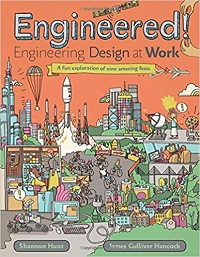| ________________
CM . . . . Volume XXIV Number 14. . . . December 8, 2017
excerpt:
Engineering Design at Work is an excellent and inspiring book that looks at how design is used in the real world and how it can improve our lives and increase our knowledge. The book’s contents contribute to a better understanding of how technology changes over time. The introduction, the landing of the Curiosity rover on Mars, is a great way to grab the interest of any reader, and it is followed by the two paragraphs of the excerpt above. The design process is given in detail over two pages and then referred to via small and large icons on almost every page of the rest of the book. The examples that are used span all types of engineering and cover a wide historical range from early computers in the 1940s to the space age and the three-dimensional printers for replacement skin tissue. Shannon Hunt has written a clear and informative text that describes and explains each topic perfectly, including interesting titles and abundant sidebars that provide further information by bringing in people actually involved in the process of design. For example, on page 27 in the section on early computers, there are two sidebars – one about team member Jack Kilby and the other about Robert Noyce, another engineer working on integrated circuits. Small icons are given within the text to lead readers to a larger icon somewhere on the page. They indicate the part of the design process that is being discussed and point to the appropriate section of the design pages. These references are carefully selected so that all stages of the design process are included somewhere in the text, although not on every page. Since every design stage is used more than once, readers can review throughout. The illustrations are as informative as the text, adding another level, or two, to each page. James Gulliver Hancock has created cartoon illustrations that have great depth and character as well as being revealing, informative and fun. So much information is included that readers can go back to learn more on a second reading/viewing. There are nine main sections given titles by the type of engineering involved, such as mechanical or bioengineering. Within each section, there is one main design although there are many more when you include all of the sidebars and other ideas illustrated on the pages. The biographies add both another layer and more design ideas. Engineering Design at Work is an exceptional book full of interesting and intriguing innovations that could easily stimulate readers into looking further into some of those ideas or into design, engineering and invention itself. This book would make an excellent addition to any library, especially one of a child interested in how things work or one who is simply curious. Highly Recommended. Willow Moonbeam started out as an engineer before becoming a community college professor and then a librarian living in Toronto, ON, with two cats and too many, or not enough, books.
Next Review |
Table of Contents for This Issue
- December 8, 2017. |
